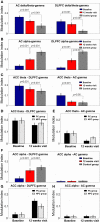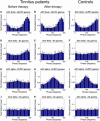Abnormal cross-frequency coupling in the tinnitus network
- PMID: 25309309
- PMCID: PMC4174755
- DOI: 10.3389/fnins.2014.00284
Abnormal cross-frequency coupling in the tinnitus network
Abstract
Neuroimaging studies have identified networks of brain areas and oscillations associated with tinnitus perception. However, how these regions relate to perceptual characteristics of tinnitus, and how oscillations in various frequency bands are associated with communications within the tinnitus network is still incompletely understood. Recent evidence suggests that apart from changes of the tinnitus severity the changes of tinnitus dominant pitch also have modulating effect on the underlying neuronal activity in a number of brain areas within the tinnitus network. Therefore, in a re-analysis of an existing dataset, we sought to determine how the oscillations in the tinnitus network in the various frequency bands interact. We also investigate how changes of tinnitus loudness, annoyance and pitch affect cross-frequency interaction both within and between nodes of the tinnitus network. Results of this study provide, to our knowledge, the first evidence that in tinnitus patients, aside from the previously described changes of oscillatory activity, there are also changes of cross-frequency coupling (CFC); phase-amplitude CFC was increased in tinnitus patients within the auditory cortex and the dorsolateral prefrontal regions between the phase of delta-theta and the amplitude of gamma oscillations (Modulation Index [MI] 0.17 in tinnitus patients vs. 0.08 in tinnitus free controls). Moreover, theta phase in the anterior cingulate region modulated gamma in the auditory (MI 0.1) and dorsolateral prefrontal regions (MI 0.19). Reduction of tinnitus severity after acoustic coordinated reset therapy led to a partial normalization of abnormal CFC. Also treatment induced changes in tinnitus pitch significantly modulated changes in CFC. Thus, tinnitus perception is associated with a more pronounced CFC within and between nodes of the tinnitus network. CFC can coordinate tinnitus-relevant activity in the tinnitus network providing a mechanism for effective communication between nodes of this network.
Keywords: alpha rhythm; coordinated reset neuromodulation; cross frequency coupling; delta band activity; gamma band activity; oscillations; tinnitus pitch.
Figures



References
LinkOut - more resources
Full Text Sources
Other Literature Sources

